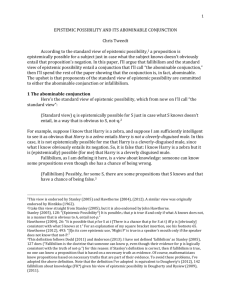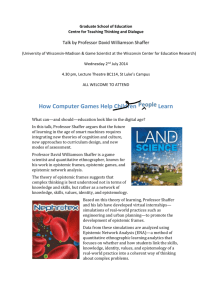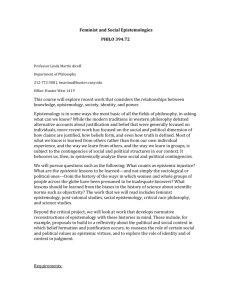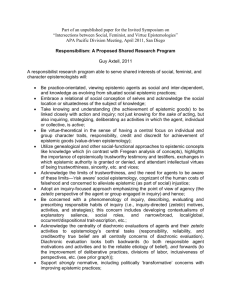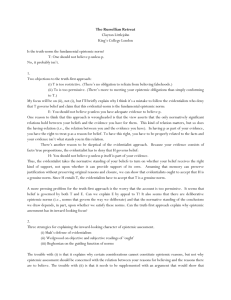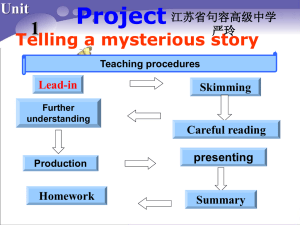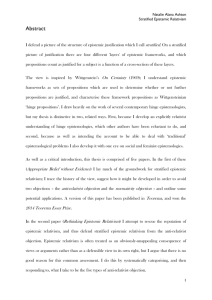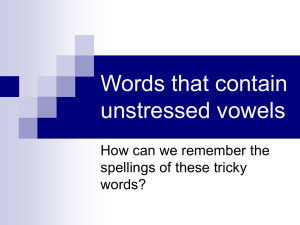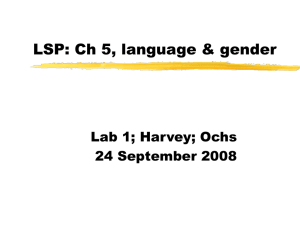EPISTEMIC POSSIBILITY AND ITS ABOMINABLE CONJUNCTION
advertisement
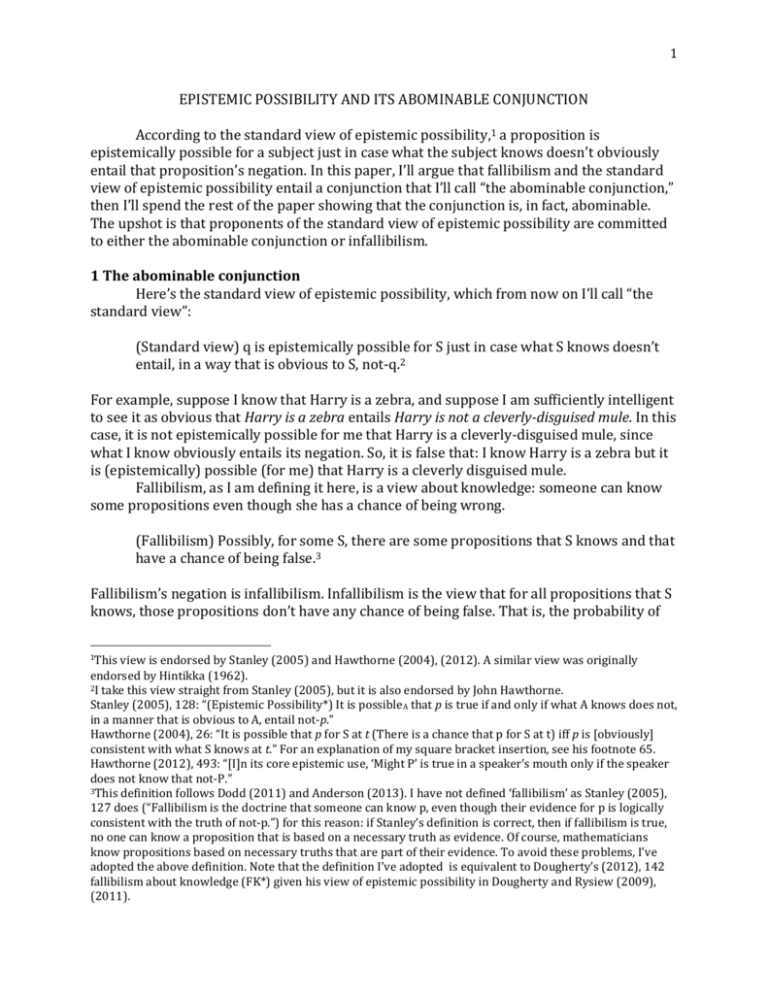
1 EPISTEMIC POSSIBILITY AND ITS ABOMINABLE CONJUNCTION According to the standard view of epistemic possibility,1 a proposition is epistemically possible for a subject just in case what the subject knows doesn’t obviously entail that proposition’s negation. In this paper, I’ll argue that fallibilism and the standard view of epistemic possibility entail a conjunction that I’ll call “the abominable conjunction,” then I’ll spend the rest of the paper showing that the conjunction is, in fact, abominable. The upshot is that proponents of the standard view of epistemic possibility are committed to either the abominable conjunction or infallibilism. 1 The abominable conjunction Here’s the standard view of epistemic possibility, which from now on I’ll call “the standard view”: (Standard view) q is epistemically possible for S just in case what S knows doesn’t entail, in a way that is obvious to S, not-q.2 For example, suppose I know that Harry is a zebra, and suppose I am sufficiently intelligent to see it as obvious that Harry is a zebra entails Harry is not a cleverly-disguised mule. In this case, it is not epistemically possible for me that Harry is a cleverly-disguised mule, since what I know obviously entails its negation. So, it is false that: I know Harry is a zebra but it is (epistemically) possible (for me) that Harry is a cleverly disguised mule. Fallibilism, as I am defining it here, is a view about knowledge: someone can know some propositions even though she has a chance of being wrong. (Fallibilism) Possibly, for some S, there are some propositions that S knows and that have a chance of being false.3 Fallibilism’s negation is infallibilism. Infallibilism is the view that for all propositions that S knows, those propositions don’t have any chance of being false. That is, the probability of This view is endorsed by Stanley (2005) and Hawthorne (2004), (2012). A similar view was originally endorsed by Hintikka (1962). 2I take this view straight from Stanley (2005), but it is also endorsed by John Hawthorne. Stanley (2005), 128: “(Epistemic Possibility*) It is possibleA that p is true if and only if what A knows does not, in a manner that is obvious to A, entail not-p.” Hawthorne (2004), 26: “It is possible that p for S at t (There is a chance that p for S at t) iff p is [obviously] consistent with what S knows at t.” For an explanation of my square bracket insertion, see his footnote 65. Hawthorne (2012), 493: “[I]n its core epistemic use, ‘Might P’ is true in a speaker’s mouth only if the speaker does not know that not-P.” 3This definition follows Dodd (2011) and Anderson (2013). I have not defined ‘fallibilism’ as Stanley (2005), 127 does (“Fallibilism is the doctrine that someone can know p, even though their evidence for p is logically consistent with the truth of not-p.”) for this reason: if Stanley’s definition is correct, then if fallibilism is true, no one can know a proposition that is based on a necessary truth as evidence. Of course, mathematicians know propositions based on necessary truths that are part of their evidence. To avoid these problems, I’ve adopted the above definition. Note that the definition I’ve adopted is equivalent to Dougherty’s (2012), 142 fallibilism about knowledge (FK*) given his view of epistemic possibility in Dougherty and Rysiew (2009), (2011). 1 2 the proposition on S’s evidence is 1.4 So, fallibilism is the view that some propositions that S knows have a probability less than 1 on S’s evidence.5 ‘Probability’ in the above paragraph is epistemic. For example, suppose a fair D20 has been rolled and has landed on 3, and suppose you are certain that the D20 will land on a number, but you have no evidence as to which one. The logical/physical probability it has not landed on 3 is 0, but the epistemic probability for you that it has not landed on 3 is .95. ‘Chance’ in the above paragraph is also epistemic. From the above example, there’s an epistemic chance for you that the D20 has not landed on 3, but there is no logical/physical chance that the D20 has not landed on 3. I’ll be assuming fallibilism in this paper, but it should be undeniable that I know some propositions for which there’s a chance that I’m wrong. The chance may be minute and not worth considering, but I have been wrong before, and neither my faculties nor my noetic structure are perfect. So it is very plausible that I know some propositions that I have a chance of being wrong about.6 Here’s the abominable conjunction: Abominable conjunction (AC) There’s a chance that p, and p is impossible. ‘Chance’ and ‘impossibility’ are both epistemic in AC. The fallibilist who endorses the standard view of epistemic possibility is committed to a true instance of the abominable conjunction whenever she fallibly knows a proposition. Whenever she fallibly knows ~p, there’s a chance that p since there’s a chance that ~p is false. Also, p is impossible, since S knows ~p, and (to anyone who is minimally competent) ~p obviously entails itself. Here’s an example. I know that the fork in front of me is metal. However, I’ve been mistaken before. What I have thought were metal forks have, in fact, been shiny, silver, plastic forks, but that is very rare. So there’s a chance that the fork in front of me is not metal. But still, given fallibilism, we may suppose that I know that the fork in front of me is metal. Is it possible (epistemically) that the fork in front of me is plastic? Not according to the standard view of epistemic possibility. On that view, since the fork in front of me is metal obviously entails the fork in front of me is not plastic, that the fork in front of me is plastic is epistemically impossible. If the standard view is correct, the following abominable conjunction is true: There’s a chance that the fork in front of me is plastic, but it’s impossible that the fork in front of me is plastic.7 4This definitional equivalence makes my definition of ‘fallibilism’ equivalent to Dodd’s (2011), 1. evidence can be total or partial. My argument will work equally as well in both cases. 6Here’s another consideration in favor of fallibilism: if E=K is false, the negation of some propositions S knows are compatible with S’s evidence, in which case the probability of some of those propositions on S’s evidence is less than 1. So, there is a chance that the proposition is false on S’s evidence. For E=K, see Williamson (2002), and for two arguments against E=K, see Comesana and Kantin (2010) and Dougherty (2013). 7Because of communativity, this equivalent abominable conjunction is also true if the standard view and (fallibilism) are true: It’s impossible that the fork in front of me is plastic, but there’s a chance that the fork in front of me is plastic. All I say in the sequel should take this equivalent formulation into account. 5The 3 So far I’ve argued that the fallibilist proponent of the standard view is committed to what I have called “the abominable conjunction.” In the next two sections, I will argue that the conjunction is, in fact, abominable. 2 Why the conjunction is abominable #1 Before I give arguments, it’s worth mentioning that the abominable conjunction seems obviously false—so obvious that it should not need argument. Where are we going to find premises that are even more obviously true than the conclusion? How can an impossible proposition have a chance of being true? Obviously it can’t. But there will be some for whom the abominable conjunction is not obviously false, so I’ll give arguments below. First, if there’s a chance that a proposition is true for someone, the epistemic probability of that proposition is greater than 0. If the probability of a proposition is greater than 0, then that proposition is included in the relevant probability space. However, only possibilities are included in probability spaces. In short, if there’s a chance that p, then p is a possible outcome. So, if a proposition is impossible, it is not included in the relevant probability space, and if it’s not included in the probability space, it doesn’t have a chance of being true. So, it’s always false that there’s a chance that p and p is impossible. The premise in need of defending is that only possibilities are included in probability spaces. To argue for this premise, Dodd gives an analogy between epistemic and physical possibility and probability. Here’s Dodd: Say that, given the distribution of air molecules in my office, the physical laws assign a non-zero probability to the event (E) of the air molecules all moving to the right hand corner of my office in the next five seconds. In other words, the physical probability of E is non-zero. Then it’s physically possible that E will happen. It doesn’t matter that the probability of E is very, very small. Make it as low as you like, as long as it’s greater than zero, E might happen. Likewise, if the probability of p is greater than zero (epistemically speaking), then it’s possible that p (epistemically speaking). In slogan form, if something has some probability of being true, it might be true. 8 A fallibilist proponent of the standard view might object that epistemic possibilities are significantly different than other kinds of probabilities such that an epistemically impossible proposition has an epistemic chance of being true but a physically impossible proposition does not have a physical chance of being true. In reply, if ‘possibility’ means something much different when it refers to an epistemic possibility than it means when it refers to a different kind of possibility, arguably ‘might’ means something much different when it refers to an epistemic might than it means when it refers to a different kind of might. If that’s true, proponents of the standard view of epistemic possibility have lost much of the traction they might have gained by treating commonsense uses of the epistemic ‘might’ and ‘possible’ as evidence for their view. As it is, the pragmatic appropriateness of using the epistemic ‘might’ and ‘possible’ make up a considerable portion of arguments for the standard view of epistemic possibility.9 Dodd (2011), 4 e.g. Lewis (1996), Hawthorne (2004), Stanley (2005), Dodd (2008), (2011), Fantl and McGrath (2009), Hawthorne (2012), and Anderson (2013). 8 9See, 4 It’s also worth noting that John Hawthorne, a proponent of the standard view of epistemic possibility, should endorse the abominableness of the conjunction, since he seems to identify there being a(n epistemic) chance that p with it being (epistemically) possible that p. For example, in his (2004), 26, he writes: “It is possible that p for S at t (There is a chance that p for S at t) iff p is consistent with what S knows at t.” Hawthorne, then, seems committed to rejecting (fallibilism). 3 Why the conjunction is abominable #2 Second, the abominable conjunction sounds wrong, crazy, and mad. If you’re a contented proponent of the standard view, in the words of David Lewis, “I implore you to be honest, be naïve, hear it afresh”10: “There is a chance it’s true, but it’s impossible.” Doesn’t that just sound wrong? Indeed, doesn’t it sound contradictory? Keith DeRose has a rule for discovering when sentences are inconsistent: [H]ow can one discover that such a sentence is inconsistent? A simple, but good, place to start is by noticing that such sentences sound inconsistent. The two halves of the sentence seem, to the ears of most of us, to cancel each other out or inexorably clash with each other. It has the feeling of a contradiction about it.11 Since the abominable conjunction sounds inconsistent, we have good reason to think it’s contradictory. Further, proponents of the standard view often argue against their opponents by claiming that their opponents’ views entail propositions that, when they are uttered, sound contradictory.12 The utterances are called “concessive knowledge attributions” (CKAs). CKAs are statements of the form ‘I know p, but it’s possible that q’ where q obviously entails not-p. For example, “I know Harry is a zebra, but it’s possible Harry is a painted mule,” and “I know the fork in front of me is metal, but it’s possible it’s plastic.” So, proponents of the standard view take it as a strike against a view if an utterance of something that the view entails sounds odd. By the lights of the proponent of the standard view, then, the odd-soundingness of uttering the abominable conjunction is a strike against their view. In fact, to my ears at least, instances of the abominable conjunction sound far worse than CKAs do. Here is an utterance of an instance of the abominable conjunction and a CKA side by side: “There’s a chance the fork in front of me is plastic, but that’s impossible.” “I know the fork in front of me is metal, but it’s possible it’s plastic.” It seems to me that in the first quote, by uttering the second conjunct, I’m taking back what I expressed by the first conjunct, and in the second quote by uttering the second conjunct I’m merely adding that my knowledge is fallible: it’s (epistemically) possible that I’m wrong. However, even if, in the second quote, I seem to be taking back what I said in the first conjunct by uttering the second, proponents of the standard view do not have a unique 10Lewis (1996), 550. (1991), 597. 12One example of this kind of argument is the quote from Keith DeRose (1991) above. Lewis (1996), Dodd (2011), and Benbaji (2009) also employ this kind of argument. 11DeRose 5 mad-sounding utterance to wield against their opponents. Their opponents are now armed with a tu quoque: utterances of the abominable conjunction. In fact, the opponents of the standard view have an advantage: they’ve developed warranted assertability maneuvers (WAMs) to explain the infelicity of CKAs. A WAM is a way of showing why an assertion can seem false even though it is true: the assertion is pragmatically inappropriate in most ordinary circumstances in which it’s asserted. Patrick Rysiew (2001) and Trent Dougherty (2009), (2011) & (ms) have provided WAMs for CKAs, but proponents of the standard view have not yet offered a WAM for utterances of the abominable conjunction. In short, the abominable conjunction sounds bad, and proponents of the standard view usually argue that the fact that CKAs sound bad works against opponents of the standard view. Instances of the abominable conjunction sound worse, though, and even if you think they don’t, some of the same considerations that proponents of the standard view thinks work for them also work against them. 6 WORKS CITED Anderson, Charity (2013). “Fallibilism and the Flexibility of Epistemic Modals” Philosophical Studies, 1-10. Benbaji, Hagit (2009). “On the Pragmatic Explanation of Concessive Knowledge Attributions” Southern Journal of Philosophy 47:3, 225-237. Comesana, Juan and Holly Kantin. “Is Evidence Knowledge?” Philosophy and Phenomenological Research 20:2, 447-454. DeRose, Keith (1991). “Epistemic Possibilities” Philosophical Review 100:4, 581-605. Dodd, Dylan (2008). “Confusion about Concessive Knowledge Attributions” Synthese 172:3, 381-396. Dodd, Dylan (2011). “Against Fallibilism” Australasian Journal of Philosophy , 1-21. Dougherty, Trent (2011). “Fallibilism” in The Routledge Companion to Epistemology, Sven Bernecker and Duncan Pritchard, eds. Taylor and Francis. Dougherty, Trent (forthcoming). “Experience First” in Contemporary Debates in Epistemology, 2nd ed., Matthias Steup, John Turri, and Earnest Sosa, eds. Dougherty, Trent (ms). “Pragmatics without Pragmatism: a Reply to Fantl & McGrath” < https://sites.google.com/site/trentdougherty/teaching/DoughertyandRysiewPragmaticswithoutPragmatism4.2.doc?attredirects=0&d=1> Dougherty, Trent, and Patrick Rysiew (2009). “Fallibilism, Epistemic Possibility, and Concessive Knowledge Attributions” Philosophy and Phenomenological Research 78 :1, 123132. Dougherty, Trent, and Patrick Rysiew (2011). “Clarity About Concessive Knowledge Attributions: Reply to Dodd” Synthese 181:3, 395-403. Fantl, Jeremy and Matthew McGrath (2009). Knowledge in an Uncertain World. Oxford University Press. Hawthorne, John (2004). Knowledge and Lotteries. Oxford University Press. Hawthorne, John (2012). “Knowledge and Epistemic Necessity” Philosophical Studies 158, 493-501. Hintikka, J. (1962). Knowledge and Belief: An Introduction to the Logic of the Two Notions. Cornell University Press. 7 Lewis, David (1996). “Elusive Knowledge” Australasian Journal of Philosophy 74:4, 549-567. Olson, Eric (1995). “Human People or Human Animals?” Philosophical Studies 80:2, 159181. Rysiew, Patrick (2001). “The Context-Sensitivity of Knowledge Attributions.” Nous 35:4, 477-514. Stanley, Jason (2005). “Fallibilism about Concessive Knowledge Attributions” Analysis 65:2, 126-131. Williamson, Timothy (2002). Knowledge and Its Limits. Oxford University Press.
